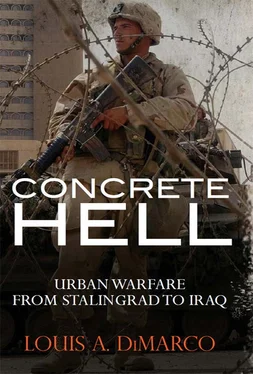The history of modern urban battles demonstrated the vast variety of scenarios in which decisive urban operations may occur. At one extreme is full conventional global war. Stalingrad and the battle of Aachen represent urban combat at that extreme of the conflict spectrum. The battles of Hue and Seoul demonstrate that similar decisive conventional urban combat is also likely to occur in smaller-scale conventional regional conflict. At the opposite end of the spectrum from global and regional conventional war is urban combat prosecuted by modern armies operating in an internal security role. In this role, fighting against terrorists and revolutionaries, urban combat more closely resembles police work than conventional military combat. The French experience in Algiers and the British experience in Belfast and Londonderry represent this part of the spectrum of urban warfare. The late 20th century and first decade of the 21st century highlighted a hybrid type of urban warfare that lies somewhere between intense conventional combat and low-intensity internal security operations. This is the type of combat prosecuted by the Israelis in Operation Defensive Shield and by US military forces in Iraq. In hybrid urban warfare, many aspects of conventional combat are present such as the requirements for artillery, air, and armor support. Hybrid urban combat, however, requires much more than sophisticated conventional military capability. Hybrid combat also requires military capabilities not normally necessary for conventional combat. These include special operations capability, civil affairs expertise, sophisticated intelligence gathering focused on the human terrain of the urban environment, and close coordination between military and political policy. To be effective, it also requires combined operations and common policy with the government and military forces representing the urban population. In the hybrid urban combat environment, military forces must be able to operate simultaneously across the entire spectrum of urban combat intensity.
In the late 1990s the US Marine Corps famously described this hybrid urban combat as the “Three Block War.” The Three Block War envisions that on one block tanks and airpower will support conventional attacks to destroy enemy combatants or capture a geographic feature. On the next block a robust military presence guards vital infrastructure and the civilian population against guerrilla and terrorist attacks. On a third block, a military unit focuses on training and working with police, rebuilding infrastructure, and establishing civilian governance institutions in close cooperation with the host government and the civilian population. This is the essence of contemporary and future urban combat. Success in the Three Block War requires ground forces organized, trained, and equipped for urban warfare in the 21st century.
The trends of military history support the idea that warfare in the 21st century will be dominated by operations in the urban environment. But it is not just military history that supports the idea of the increasing decisiveness of urban combat. The importance of urban combat is also supported by population demographics. Since World War II, increased access to modern medicine has led to a global population explosion. Between 1990 and 2009 the global population increased 28 percent. It has increased even more dramatically in developing parts of the world, areas that are the most likely setting for warfare in the 21st century: Africa’s population has increased by 58 percent while the population of the Middle East has grown by 54 percent.
That dramatic increase in global population has been accompanied by a vast global rural to urban migration. In 1800, only 3 percent of the world’s population lived in cities, but by 2000 almost one half of the global population lived in cities. By the year 2030 the UN projects that 60 percent of the world population will live in cities. This shift from rural to urban population will be most dramatic in those developing nations where simultaneously the population growth is most dramatic: in Africa, the Middle East, and Asia. An important subset of this move by people to the urban environment is the accompanying growth of urban ghettos and shantytowns. One-third of the global urban population lives in poverty and disease-ridden urban ghettos. This environment is characterized by crime, disease, and political unrest. Warfare is conducted in response to politics; politics is the interaction of citizens in society; and increasingly in the 21st century those citizens will interact in, and be citizens of, cities. Urban combat will be the most likely type of combat, regardless of the specific political circumstances prompting war in the 21st century, simply because the urban environment will be the dominant residential environment across the globe.
The most recent important military activities support the trend that urban operations will dominate warfare in the 21st century. The US military operations in Iraq from 2003 to 2011 were conducted almost entirely within Iraq’s large cities. The 2011 Libyan civil war that resulted in the overthrow of the dictator Colonel Muammar Gaddafi was primarily a conflict fought in Libya’s urban centers. The war began in the city of Benghazi in February 2011 and was characterized by government and rebel forces fighting for possession of Libya’s important coastal cities. The rebels won the war and successfully ousted the dictator when they successfully captured Gaddafi’s capital city, Tripoli, in August 2011. The same type of popular urban discontent that swept through Libya affected other Middle Eastern dictatorships in 2011 and 2012. In all cases, that discontent was centered among the large urban populations. In some cases, such as Egypt, major military operations were avoided as the government addressed the discontent by responding to the demands for reform.
In other countries, such as Syria, the disaffected urban population rose up, resulting in brutal urban combat involving revolting citizens and dissident military units on one side and the army loyal to the government on the other. Thousands of civilian casualties and millions of dollars of infrastructure damage resulted. The historical trends represented by the case studies in this book, combined with global demographic trends, and validation from the most recent significant military actions resulting from the “Arab Spring” of 2011 indicate that future ground warfare will undoubtedly focus on operations in and around the world’s cities. Also, it is unlikely that future urban combat will be conducted on a small scale. In 2007 there were 468 cities with populations over one million. Modern militaries must be prepared to enter these large cities and conduct effective operations, and this will require the military capability to be effective in an environment of over a million potentially hostile civilians.
Preparing for war in the future means preparing to fight in the world’s large cities. History illustrates many of the capabilities that the ground forces will need in future urban combat. The forces must be well trained and technically competent. The Russian experience in Grozny demonstrated that conscripted forces are likely to suffer grievously in urban combat and, as importantly, are likely to respond to the challenges of intense urban combat with indiscriminate or poorly coordinated violence resulting in inordinate civilian casualties. Success in the urban environment without extensive civilian casualties requires professional military forces. The force, however, does not have to be large. If the battle space is properly structured and sufficient time is allowed for operations, even relatively small combat forces can be very successful. The battles in Aachen, Seoul, Hue, and Ramadi all demonstrate that small but well-trained forces can be successful, even in intense urban combat, if well led.
Читать дальше












